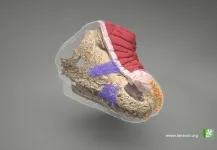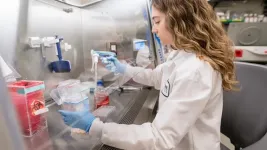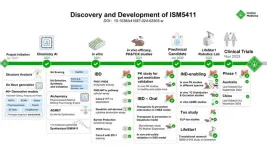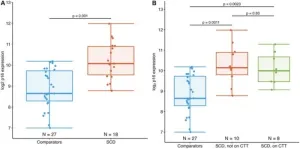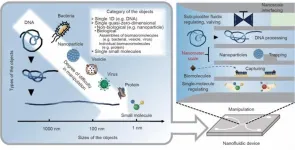(Press-News.org) How can we explain the morphological diversity of living organisms? Although genetics is the answer that typically springs to mind, it is not the only explanation. By combining observations of embryonic development, advanced microscopy, and cutting-edge computer modelling, a multi-disciplinary team from the University of Geneva (UNIGE) demonstrate that the crocodile head scales emerge from the mechanics of growing tissues, rather than molecular genetics. The diversity of these head scales observed in different crocodilian species therefore arises from the evolution of mechanical parameters, such as the growth rate and stiffness of the skin. These results, published in the journal Nature, shed new light on the physical forces involved in the development and evolution of living forms.
The origin of the morphological diversity and complexity of living organisms remains one of science’s greatest mysteries. To solve this puzzle, scientists study a wide range of different species. The laboratory of Michel Milinkovitch, professor in the Department of Genetics and Evolution at the UNIGE Faculty of Science, investigates the development and evolution of vertebrate skin appendages, such as feathers, hair, and scales, to understand the fundamental mechanisms responsible for this diversity. The embryonic development of these appendages is generally thought to be dictated by chemical processes involving interactions between numerous molecules resulting from gene expression.
Like a propagating crack
Previously, the team showed that the embryonic development of crocodile head scales, unlike scales of the body, originates from a process reminiscent of the propagation of cracks within a material under mechanical stress. However, the true nature of this physical process remained unknown.
These scientists have now solved this mystery thanks to their new and highly multidisciplinary work. First, they tracked the appearance of head scales during the development of the Nile crocodile embryo, which lasts around 90 days in total. While the skin covering the jaws remains smooth until day 48, skin folds appear at around day 51. These folds then spread and interconnect to form irregular polygonal scales, including large and elongated scales on the top of the snout, and smaller units on the sides of the jaws.
If the skin of an animal grows more quickly than the underlying tissue to which it is attached, you can expect the skin to buckle and fold, as its growth is constrained. The team sought to explore whether such a process can explain the appearance of skin folds, and hence scales, in the embryonic crocodile. Therefore, they developed a technique for injecting crocodile eggs with a hormone that activates epidermal growth and stiffening - EGF (Epidermal Growth Factor). The scientists discovered that the activation of growth and increased rigidity of the skin’s surface led to a spectacular change in the organisation of skin folds.
‘‘We saw that the embryo’s skin folds abnormally and forms a labyrinthine network resembling the folds of the human brain. Amazingly, when these EGF-treated crocodiles hatch, this brain-like folding has relaxed into a pattern of much smaller scales, comparable to those of another crocodilian species - the caiman,’’ explain Gabriel Santos-Durán and Rory Cooper, post-doctoral fellows in Michel Milinkovitch’s laboratory and co-authors of the study. Therefore, variations in the rate of growth and stiffening of the skin provide a simple evolutionary mechanism capable of generating a wide diversity of scale forms among different crocodilian species.
A 3D model of jaw development
The scientists then used an advanced imaging technique, known as ''light sheet microscopy'', to quantify the growth rate and geometries of the various tissues (epidermis, dermis, and bone) that comprise the embryo’s head, as well as the organisation of collagen fibres in the dermis. The team used these data to build a three-dimensional (3D) computer model to simulate the constrained growth of the skin. This model also allowed the researchers to explore the effects of changing the specific growth rates and stiffnesses of the tissue layers.
‘‘By exploring these different parameters, we can generate the different head scale shapes corresponding to Nile crocodiles both with or without EGF treatment, as well as the spectacled caiman or the American alligator. These computer simulations demonstrate that tissue mechanics can easily explain the diversity of shapes of certain anatomical structures in different species, without having to involve intricate molecular genetic factors,’’ concludes Ebrahim Jahanbakhsh, a computer engineer in Michel Milinkovitch’s laboratory and co-author of the study.
END
Biological diversity is not just the result of genes
A UNIGE study reveals how mechanics, linked to tissue growth, help generate the diversity of biological structures
2024-12-11
ELSE PRESS RELEASES FROM THIS DATE:
Analysis reveals an additional mechanism behind statin therapy’s heart-related benefits in people with HIV
2024-12-11
Investigators who previously found that a daily statin pill helps prevent heart attacks and strokes in people with HIV have now discovered a potential mechanism that may help to stabilize plaques and prevent their rupture in blood vessels. The research led by a team from Mass General Brigham is published in JAMA Cardiology.
“Individuals with HIV tend to have an excess of noncalcified plaques that are vulnerable to rupture at a younger age, putting them at high risk for strokes, heart attacks, and sudden cardiac death,” said senior author Steven Grinspoon, MD, chief of the Metabolism Unit at Massachusetts General Hospital, a founding member of the Mass General Brigham healthcare ...
Understanding how the immune system switches between rest and action
2024-12-11
SAN FRANCISCO—Cells in the immune system don’t always fight; they often rest and wait for threats, like viruses or bacteria. When such threats emerge, the cells activate to defend the body. This delicate balance between rest and activation is crucial to our health—immune cells must be poised for activation to protect against threats, but if they’re overly active, autoimmune diseases can result.
But what controls this important balance?
In a new study published in Nature, scientists from Gladstone Institutes and UC San Francisco ...
Wiley expands its KnowItAll solutions with new tools for LC-MS analysis, enterprise data management, and additional spectral advances
2024-12-11
HOBOKEN, N.J.—Wiley, one of the world’s largest publishers and a global leader in research and learning, today announced the release of the new version of its KnowItAll software, with numerous advances to accelerate spectral analysis and optimize workflows.
KnowItAll 2025, the latest version of Wiley’s comprehensive software suite for spectral analysis and analytical data management, introduces a groundbreaking new tool to automate LC-MS analysis, enhanced data management, and numerous other features to streamline analysis across multiple ...
A new class of antivirals could help prevent future pandemics
2024-12-11
The arrival of Paxlovid in December 2021 marked another turning point in the COVID-19 pandemic—an effective antiviral that has since successfully treated millions. But like many antivirals before it, scientists know that at some point, Paxlovid is likely to lose some efficacy due to drug resistance. Researchers working to stay ahead of such emerging threats have now identified a wholly new way to treat SARS-CoV-2 infections—work that may have even broader implications.
In fact, a new study by the Tuschl ...
Nature Biotechnology | Generative chemistry enables Insilico to develop gut-restricted PhD inhibitors promising for intestinal mucosal barrier repair and immunomodulation
2024-12-11
The study presents the journey of designing and optimizing novel gut-restricted PHD inhibitors using the comprehensive generative chemistry engine Chemistry42.
From initiation to preclinical candidate nomination, the program spanned only 12 months, during which approximately 115 molecules were synthesized and screened.
Preclinical studies demonstrate ISM5411 to be gut-restricted and PHD-specific, thus reducing cardiovascular and systematical tumorigenic risks.
Two Phase 1 clinical trials of ISM5411 for IBD are currently being conducted in parallel in Australia and China, with the last subject out in both ...
2 U-M faculty members elected to National Academy of Inventors
2024-12-11
ANN ARBOR—Two University of Michigan faculty members have been elected to the National Academy of Inventors, the highest professional distinction awarded solely to inventors.
Robert Bartlett, professor emeritus of surgery at the Medical School, and Zhen Xu, professor of biomedical engineering at the College of Engineering and professor of radiology and neurosurgery at the Medical School, were elected this month to the academy.
Bartlett and Xu were nominated for being innovative researchers with extensive work translating discoveries into ...
Breakthroughs in cell-penetrating monoclonal antibody therapies
2024-12-11
“Monoclonal antibodies (mAb) have emerged as a promising tool in advancing personalized medicine.”
BUFFALO, NY – December 11, 2024 – A news feature on the research paper “Next-generation cell-penetrating antibodies for tumor targeting and RAD51 inhibition” by Rackear et al. was published in Oncotarget’s Volume 15 on November 22, 2024, titled “Advancements in cell-penetrating monoclonal antibody treatment.“
This new publication by Sai Pallavi Pradeep and Raman Bahal from the Department of Pharmaceutical Sciences at the University of Connecticut highlights significant advancements in ...
Accelerated aging in young sickle cell patients linked to elevated T-cell p16INK4a
2024-12-11
“These initial results suggest that individuals with SCD have a significantly higher cellular senescence burden which may contribute to premature aging, physiological decline, and excess morbidities.”
BUFFALO, NY- December 11, 2024 – A new research paper was published in Aging (listed by MEDLINE/PubMed as “Aging (Albany NY)” and “Aging-US” by Web of Science) Volume 16, Issue 21 on November 14, 2024, entitled, “Adolescents and young adults with sickle cell disease exhibit accelerated aging with elevated T-cell p16INK4a expression.”
Researchers Samuel R. Wilson, Natalia Mitin, ...
Nanofluidic devices redefining matter manipulation at an unprecedented level
2024-12-11
One of the great ambitions in the scientific world is to use tiny objects—such as molecules, viruses, and nanoparticles—as building blocks to construct essential macromolecules and materials, much like constructing intricate designs with LEGO bricks. However, achieving this requires overcoming significant challenges. Molecules in liquid environments move randomly and at extraordinary speeds—approximately many times faster than Usain Bolt at peak velocity—making precise manipulation extraordinarily challenging.
To ...
Powering the future together – Public-Private Collaboration for the energy transition in Finland
2024-12-11
Advancing the energy transition requires more than just technological innovation – it demands a joint effort between public and private actors. Giovanna Pinilla De La Cruz’s doctoral dissertation at the University of Vaasa, Finland, explores the mechanisms that foster collaboration in the energy sector, highlighting the Vaasa region’s energy cluster as a successful example.
The transition to sustainable energy systems is one of the most pressing challenges of our time. Successfully navigating this transition requires coordinated ...
LAST 30 PRESS RELEASES:
Researchers identify gene that calms the mind and improves attention in mice
Artificial metabolism turns waste CO2 into useful chemicals
Ancient sea anemone sheds light on animal cell type evolution
Begging gene leads to drone food
How climate policies that incentivize and penalize can drive the clean energy transition
Can community awareness campaigns in low-resource areas improve early diagnosis of colorectal cancer?
Stardust study resets how life’s atoms spread through space
Practical education: Clinical scenario-based program development
The impact of family dynamics on eating behaviour – how going home for Christmas can change how you eat
Tracing the quick synthesis of an industrially important catalyst
New software sheds light on cancer’s hidden genetic networks
UT Health San Antonio awarded $3 million in CPRIT grants to bolster cancer research and prevention efforts in South Texas
Third symposium spotlights global challenge of new contaminants in China’s fight against pollution
From straw to soil harmony: International team reveals how biochar supercharges carbon-smart farming
Myeloma: How AI is redrawing the map of cancer care
Manhattan E. Charurat, Ph.D., MHS invested as the Homer and Martha Gudelsky Distinguished Professor in Medicine at the University of Maryland School of Medicine
Insilico Medicine’s Pharma.AI Q4 Winter Launch Recap: Revolutionizing drug discovery with cutting-edge AI innovations, accelerating the path to pharmaceutical superintelligence
Nanoplastics have diet-dependent impacts on digestive system health
Brain neuron death occurs throughout life and increases with age, a natural human protein drug may halt neuron death in Alzheimer’s disease
SPIE and CLP announce the recipients of the 2025 Advanced Photonics Young Innovator Award
Lessons from the Caldor Fire’s Christmas Valley ‘Miracle’
Ant societies rose by trading individual protection for collective power
Research reveals how ancient viral DNA shapes early embryonic development
A molecular gatekeeper that controls protein synthesis
New ‘cloaking device’ concept to shield sensitive tech from magnetic fields
Researchers show impact of mountain building and climate change on alpine biodiversity
Study models the transition from Neanderthals to modern humans in Europe
University of Phoenix College of Doctoral Studies releases white paper on AI-driven skilling to reduce burnout and restore worker autonomy
AIs fail at the game of visual “telephone”
The levers for a sustainable food system
[Press-News.org] Biological diversity is not just the result of genesA UNIGE study reveals how mechanics, linked to tissue growth, help generate the diversity of biological structures
